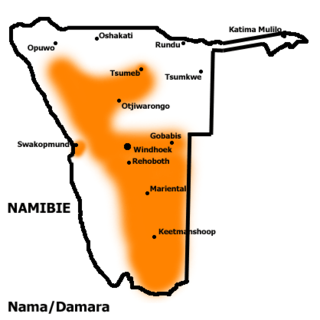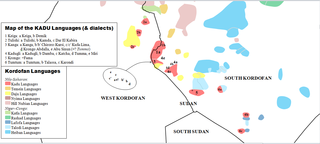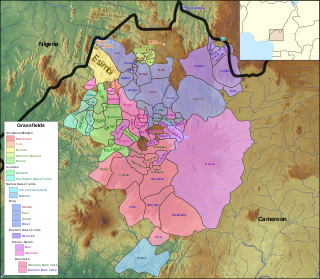
The Kordofanian languages are a geographic grouping of five language groups spoken in the Nuba Mountains of the South Kordofan region of Sudan: Talodi–Heiban languages, Lafofa languages, Rashad languages, Katla languages and Kadu languages. The first four groups are sometimes regarded as branches of the hypothetical Niger–Congo family, whereas Kadu is now widely seen as a branch of the proposed Nilo-Saharan family.

Niger–Congo is a hypothetical language family spoken over the majority of sub-Saharan Africa. It unites the Mande languages, the Atlantic-Congo languages, and possibly several smaller groups of languages that are difficult to classify. If valid, Niger-Congo would be the world's largest in terms of member languages, the third-largest in terms of speakers, and Africa's largest in terms of geographical area. It is generally considered to be the world's largest language family in terms of the number of distinct languages, just ahead of Austronesian, although this is complicated by the ambiguity about what constitutes a distinct language; the number of named Niger–Congo languages listed by Ethnologue is 1,540.

The KhoekhoeKOY-koy language, also known by the ethnic terms Nama (Namagowab) NAH-mə, Damara (ǂNūkhoegowab), or Nama/Damara and formerly as Hottentot, is the most widespread of the non-Bantu languages of Southern Africa that make heavy use of click consonants and therefore were formerly classified as Khoisan, a grouping now recognized as obsolete. It belongs to the Khoe language family, and is spoken in Namibia, Botswana, and South Africa primarily by three ethnic groups: Namakhoen, ǂNūkhoen, and Haiǁomkhoen.
Naro, also Nharo, is a Khoe language spoken in Ghanzi District of Botswana and in eastern Namibia. It is one of the most-spoken of the Tshu–Khwe languages. Naro is a trade language among speakers of different Khoe languages in Ghanzi District. There exists a dictionary.

The Kadu languages, also known as Kadugli–Krongo or Tumtum, are a small language family of the Kordofanian geographic grouping, once included in Niger–Congo. However, since Thilo Schadeberg (1981), Kadu is widely seen as Nilo-Saharan. Evidence for a Niger-Congo affiliation is rejected, and a Nilo-Saharan relationship is controversial. A conservative classification would treat the Kadu languages as an independent family.

The Temein languages, or Nuba Hills languages, are a group of Eastern Sudanic languages spoken in the Nuba Mountains of Sudan.
The Koti language, or Ekoti, is a Bantu language spoken in Mozambique by about 64,200 people. Koti is spoken on Koti Island and is also the major language of Angoche, the capital of the district with the same name in the province of Nampula.

The Rashad languages form a small language family in the Nuba Hills of Sudan. They are named after Rashad District of South Kordofan.
Komo is a Nilo-Saharan language spoken by the Kwama (Komo) people of Ethiopia, Sudan and South Sudan. It is a member of the Koman languages. The language is also referred to as Madiin, Koma, South Koma, Central Koma, Gokwom and Hayahaya. Many individuals from Komo are multilingual because they are in close proximity to Mao, Kwama and Oromo speakers. Komo is closely related to Kwama, a language spoken by a group who live in the same region of Ethiopia and who also identify themselves as ethnically Komo. Some Komo and Kwama speakers recognize the distinction between the two languages and culture, whereas some people see it as one "ethnolinguistic" community. The 2007 Ethiopian census makes no mention of Kwama, and for this reason its estimate of 8,000 Komo speakers may be inaccurate. An older estimate from 1971 places the number of Komo speakers in Ethiopia at 1,500. The Komo language is greatly understudied; more information is being revealed as researchers are discovering more data about other languages within the Koman family.

The Talodi–Heiban languages are a proposed branch of the hypothetical Niger–Congo family, spoken in the Nuba Mountains of Sudan. The Talodi and Heiban languages are thought to be distantly related by Dimmendaal, though Glottolog 4.4 does not accept the unity of Talodi–Heiban pending further evidence.
Koalib is a Niger–Congo language in the Heiban family spoken in the Nuba Mountains of southern Sudan. The Koalib Nuba, Turum and Umm Heitan ethnic groups speak this language.
Moro is a Kordofanian language spoken in the Nuba Mountains of South Kordofan, Sudan. It is part of the Western group of West Central Heiban Kordofonian languages and belongs to the Niger-Congo phylum. In 1982 there were an estimated 30,000 Moro-speakers. This was before the second Sudan civil war and therefore the recent number of speakers might differ. There can be noted an influence of Arabic and it is suspected that today approximately a fourth of all Moro vocabulary has a relation or an origin in the Arabic language.
Lumun (Lomon), also Kuku-Lumun, is a Niger–Congo language in the Talodi family spoken in the Nuba Mountains, Sudan.

Tegali is a Kordofanian language in the Rashad family, which is thought by some to belong to the hypothetical Niger–Congo phylum. It is spoken in South Kordofan state, Sudan.
Afitti is a language spoken on the eastern side of Jebel el-Dair, a solitary rock formation in the North Kordofan province of Sudan. Although the term ‘Dinik’ can be used to designate the language regardless of cultural affiliation, people in the villages of the region readily recognize the terms ‘Ditti’ and ‘Afitti.’ There are approximately 4,000 speakers of the Afitti language and its closest linguistic neighbor is the Nyimang language, spoken west of Jebel el-Dair in the Nuba Mountains of the South Kordofan province of Sudan.
Talodi or Jomang, is a Niger–Congo language in the Talodi family spoken in South Kordofan, Sudan. Talodi is spoken in Tasomi and Tata villages.
Kuteb also known as Ati, Kutev, Mbarike is a Nigerian ethnic language. The Kuteb people mostly live in the southern part of Taraba state in Nigeria, with a thousand-or-so speakers across the border in Cameroon. In Nigeria, it is spoken mostly in Takum and Ussa LGAs, and Yangtu SDA Taraba State.
Acheron (Asheron) is a Niger–Congo language in the Talodi family of Kordofan, Sudan.

The Babanki, or Kejom, language is a Bantoid language that is spoken by the Babanki people of the Western Highlands of Cameroon.
Proto-Bantu is the reconstructed common ancestor of the Bantu languages, a subgroup of the Southern Bantoid languages. It is thought to have originally been spoken in West/Central Africa in the area of what is now Cameroon. About 6,000 years ago, it split off from Proto-Southern Bantoid when the Bantu expansion began to the south and east. Two theories have been put forward about the way the languages expanded: one is that the Bantu-speaking people moved first to the Congo region and then a branch split off and moved to East Africa; the other is that the two groups split from the beginning, one moving to the Congo region, and the other to East Africa.







